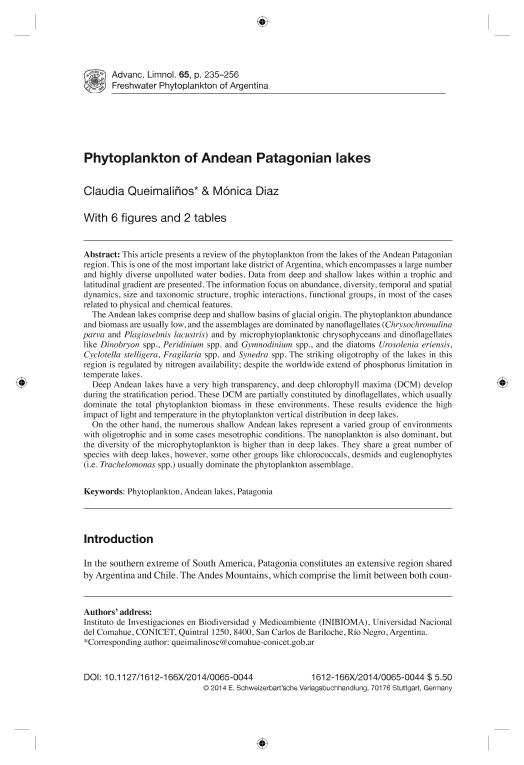Artículo
Phytoplankton of the Andean Lakes
Fecha de publicación:
07/2014
Editorial:
Schweizerbart
Revista:
Advances in Limnology, Archiv Fur Hydrobiologie, Special Issues
ISSN:
1612-166X
Idioma:
Inglés
Tipo de recurso:
Artículo publicado
Clasificación temática:
Resumen
This chapter presents a review of the phytoplankton from the lakes of the Andean Patagonian region. This is one of the most important lake district of Argentina, which encompasses a large number and highly diverse unpolluted water bodies. Data from deep and shallow lakes within a trophic and latitudinal gradient are presented. The information focus on abundance, diversity, temporal and spatial dynamics, size and taxonomic structure, trophic interactions, functional groups, in most of the cases related to physical and chemical features. The Andean lakes comprise deep and shallow basins of glacial origin. The phytoplankton abundance and biomass are usually low, and the assemblages are dominated by nanoflagellates (Chrysochromulina parva and Plagioselmis lacustris) and by microphytoplanktonic chrysophyceans and dinoflagellates like Dinobryon spp., Peridinium spp. and Gymnodinium spp., and the diatoms Urosolenia eriensis, Cyclotella stelligera, Fragilaria spp. and Synedra spp. The striking oligotrophy of the lakes in this region is regulated by nitrogen availability; despite the worldwide extend of phosphorus limitation in temperate lakes. Deep Andean lakes have a very high transparency, and deep chlorophyll maxima (DCM) develop during the stratification period. These DCM are partially constituted by dinoflagellates, which usually dominate the total phytoplankton biomass in these environments. These results evidence the high impact of light and temperature in the phytoplankton vertical distribution in deep lakes. On the other hand, the numerous shallow Andean lakes represent a varied group of environments with oligotrophic and in some cases mesotrophic conditions. The nanoplankton is also dominant, but the diversity of the microphytoplankton is higher than in deep lakes. They share a great number of species with deep lakes, however, some other groups like chlorococcals, desmids and euglenophytes (i.e. Trachelomonas spp.) usually dominate the phytoplankton assemblage.
Palabras clave:
Phytoplankton
,
Andean Lakes
,
Patagonia
Archivos asociados
Licencia
Identificadores
Colecciones
Articulos(INIBIOMA)
Articulos de INST. DE INVEST.EN BIODIVERSIDAD Y MEDIOAMBIENTE
Articulos de INST. DE INVEST.EN BIODIVERSIDAD Y MEDIOAMBIENTE
Citación
Queimaliños, Claudia Patricia; Diaz, Monica Mabel; Phytoplankton of the Andean Lakes; Schweizerbart; Advances in Limnology, Archiv Fur Hydrobiologie, Special Issues; 65; 7-2014; 235-256
Compartir
Altmétricas




